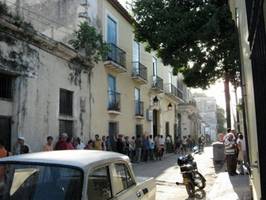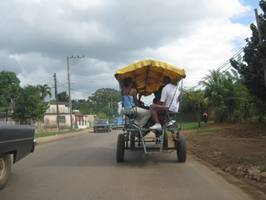 A journalist, writing about traffic accidents, said that Cuba has one of the lowest rates — 6.5 deaths per hundred thousand inhabitants — and adds that, since 1963 there is a downward trend. I do not question his statistics but, to better understand them, it is necessary to consider some factors that are obvious.
A journalist, writing about traffic accidents, said that Cuba has one of the lowest rates — 6.5 deaths per hundred thousand inhabitants — and adds that, since 1963 there is a downward trend. I do not question his statistics but, to better understand them, it is necessary to consider some factors that are obvious.
In the decade of the fifties Cuba had one (1) automobile for every forty (40) people. Then, our population was six million five hundred thousand (6,500,000) inhabitants. You can imagine the traffic density. The triumph of the insurrection stopped the massive import of cars (they were brought only for leaders and senior government officials), so it is natural that from the year 1963 (as the existing fleet aged or broke down) accidents would diminish.
In the early sixties care almost ceased to move (they became prehistoric animals), and you could cross any street in slow motion, without danger of being run over. Some Skodas were imported from Czechoslovakia, mainly for foreign experts and specialists based in the country, along with VWs and Alfa Romeos for State Security, and some of the latter, for senior leaders.
 In the decade of the seventies, after the failure of the Ten Million Ton Harvestt, when the now extinct Soviet Union and the socialist camp decided to increase the diameter of the “subsidies pipe” to save their Latin American showcase, a part of the credits not paid, was invested in importing cars — Ladas, Moscovitches and the so-called Polaquitos — the first for the Nomenklatura and professionals in charge (who were granted the right to buy), the latter primarily for personnel in health and education (same conditions), and the third to less important posts. There were also some Volgas and Fiats for State use, especially for college graduates, when it was a national goal to have a college educations.
In the decade of the seventies, after the failure of the Ten Million Ton Harvestt, when the now extinct Soviet Union and the socialist camp decided to increase the diameter of the “subsidies pipe” to save their Latin American showcase, a part of the credits not paid, was invested in importing cars — Ladas, Moscovitches and the so-called Polaquitos — the first for the Nomenklatura and professionals in charge (who were granted the right to buy), the latter primarily for personnel in health and education (same conditions), and the third to less important posts. There were also some Volgas and Fiats for State use, especially for college graduates, when it was a national goal to have a college educations.
With the demise of socialism, came the era of Chinese bicycles, which flooded our cities and towns, ridden by inexperienced people, with total disregard for traffic regulations, both day and night (without means of lighting, which were never imported). At that time accidents were the order of the day. With the creation of joint ventures and a certain economic revival in the late nineties and early 2000, the bikes disappeared (which had come to stay), and cars of capitalist origin began appearing (Tiko, Toyota, Hyundai, etc.) and some Mercedes Benz for top leaders, and others officially called ostentatious, acquired for by artists (mostly musicians) and high performance athletes.
In recent years, they have mainly imported China-made vehicles, cars and buses and trucks, and this has increased traffic some, despite the poor condition of many roads, which has concentrated traffic on the few passable roads. Today, more than eleven million inhabitants, although figures are not published, and we must be very far from the car for every forty people. Considering all these factors, not addressed by the journalist, it makes sense that regardless of all regulatory and organizational measures taken by relevant authorities, accidents have decreased. It’s a simple equation: fewer vehicles traveling equals fewer accidents. When comparing statistics with other countries, all this must be considered.
November 10 2011
